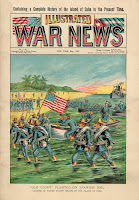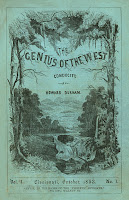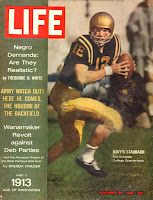
I am often asked what is the most I've ever spent on any individual item. The answer is that in 2007 I purchased a complete run of The Illustrated California News (ICN) for $15,000.
As you can see it is a great rarity, only two holdings are listed in the Union List of Serials.
I owned one issue previously (and still do) , which I bought from Periodyssey but the opportunity to obtain a complete file of six issues was too hard to resist. As the first of its genre it represents a key title to obtain.
It is remarkable that America's first illustrated newspaper (IN) began in the brand new state of California, spurred no doubt, as many other commercial ventures, out of the boom of the gold rush. This magazine then gives me an opportunity to discuss the entire genre and, of course, show off some of the highlights of my collection.
The first publication to use the term "illustrated news" was the British London Illustrated News in 1842.
Here's one of the great illustrations from ICN.
and a nice discussion of illustrated newspapers, and in particular Gleason's and Ballou's, commonly encountered titles from the 1850's.
The most commonly encountered IN's are Harper's Weekly and Frank Leslie's Illustrated Newspaper, the latter being somewhat less common and, in some cases, having more graphic images.
Here, for instance, is the issue following the assassination of Abraham Lincoln.
The issues depicting early baseball are particularly valuable. Harper's Weekly's claim to fame are the illustrations of Winslow Homer ("Snap the Whip" the most valuable) and Thomas Nast, the creator of the Republican elephant, Democratic donkey and Tammany tiger, as well as the modern image of Santa Claus.
Successful magazines invariably produce clones. Here is a rare title, Kelley's Weekly, that bears a strong resemblence in format to Harper's Weekly. Interestingly, this issue contains an original contribution by Mark Twain, the earliest of any part, containing unique illustrations, of what became "Innocent's Abroad".
Some early and rare examples of IN's. Illustrated News was published by none other than the irrepressible showman P.T Barnum.
There were even titles published in German.
The format also was used for specialty magazines as well.
and, of course, the Confederates (after all these magazines are American, albeit of the secessionist variety) were soon to publish an IR of their own, having less pages due to a lack of raw materials. These issues are obviously quite rare, the earliest and latest even moreso.
After California, many cities (some relatively small) had their own titles. The Chicago title is quite rare as is, obviously, the one from Sioux Falls. Note the image of the great Walt Whitman, just one of the many benefits of collecting periodicals.
So, you see, there really is a method to my madness!
Periodically yours,
SL




















































